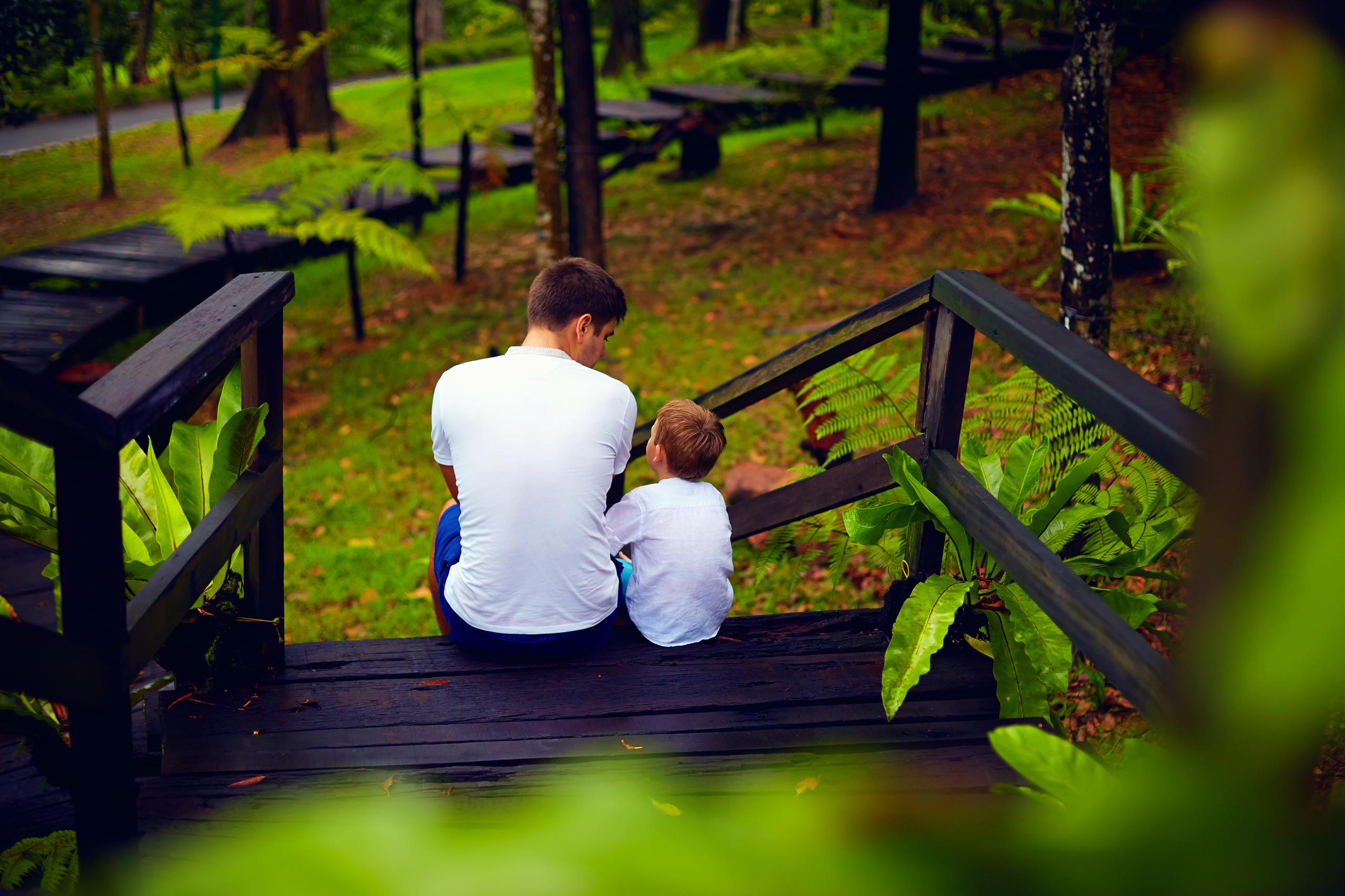whatever’s bugging you.
Tap-Tap-Tap-Tap-Tap.
A woodpecker drumming is a familiar sound, especially in early spring when the birds are establishing their territories and trying to attract mates. But the unsightly property damage they cause, along with their noise, makes woodpeckers less than desirable neighbors.
Before You Take Action
Woodpeckers are protected under the federal North American Migratory Bird Act. It is illegal to kill, harm, or trap a woodpecker in Minnesota without a permit. Furthermore, it is illegal to harass woodpeckers during their nesting season. Click here to get the Migratory Bird Depredation Application.
Management
Woodpeckers are beautiful birds, but can be a nuisance when they nest in a structure. Since they are a federally protected species, there are limited things that we can do to remove them from a structure. Nevertheless, prevention and non-lethal control methods can be utilized successfully to deal with these birds when encountered.
Bird Deterrents/Repellents
Visual deterrents/ scare devices, such as screw eyes, owl, hawk, falcon, etc. can be used to scare the birds away. Scare devices are usually attached to the structure near corners, windows, soffits, or damaged areas. These devices will not provide a long-term solution, as woodpeckers will get use to them over time.
Netting
Netting is an important exclusion method for birds. It requires skills and proper tools. It is also labor intensive and expensive. A ¾-inch bird netting is usually used to completely deny access to the woodpeckers target area. In this area, at least 2-4 inches of space is left between the building and the netting.
Repellent
Woodpecker-deterrent hole fillers are commonly used where woodpeckers have drilled to prevent further damage. Woodpecker repellant sprays are used as taste aversion means and usually applied over the entire problem area to deter future drilling. A protective woodpecker paint additive is also available for long-lasting extra protection. Caution should be used as some repellents may stain wood and cause an unattractive color to the siding. To date, there are no reliable odor repellents for use against woodpeckers. Using naphthalene (mothballs) and other volatile chemicals may produce unpleasant, pungent, sickly-sweet odor and can cause damage to the user’s eyes.
Prevention
Remove bird feeders, especially the suet type, from the area.
Inspect and treat the siding for wood destroying organisms. Insecticide use is not a practical alternative. A paint additive to repel small insects may have some favorable effect on limiting the woodpeckers’ food source.
Houses painted an earth tone color and located near woods are more attractive to woodpeckers. Changing paint color and cutting down or trimming nearby trees may help.
Woodpeckers are protected under the federal North American Migratory Bird Act. It is illegal to kill, harm, or trap a woodpecker in Minnesota without a permit. Furthermore, it is illegal to harass woodpeckers during their nesting season. Click here to get the Migratory Bird Depredation Application.
Please Note: Due to woodpeckers’ federal protection, Adam’s does not offer control services for woodpeckers. The following information is provided to help you understand these birds and how you can discourage them from damaging your property.
Facts
There are 200 species of woodpeckers in the world. Nine species are found in Minnesota.
Woodpeckers have a long tongue. It can be up to 4 inches long, depending on the species. The tongue is wrapped inside around the skull when not used. In order to feed, the woodpecker expands its barbed tongue to extract bugs from trees and holes.
Woodpeckers have natural enemies that eat their eggs. These include, but are not limited to, wild cats, and foxes. Also, big predatory birds, such as sharp-shinned hawks and Cooper’s hawks, will feed on adult woodpeckers.
Identification
Woodpeckers are usually black-and-white in color. Some are marked with red, and a few are marked with yellow. These birds range in size from the 6 inch to 19-inch long. The key future of woodpeckers is their strong beaks with chisel like tip. Woodpeckers have short legs, stiff tails and long tongues. Depending on the species, some species may have feet with four toes, two pointing forward and two pointing backward. Several species of woodpeckers have only three toes.
Lewis’s Woodpecker Melanerpes lewis (A)
- Large woodpecker
- 10 to 11 inches in length
- Mainly blackish-green; gray collar and upper breast; pinkish belly and a red face
Red-headed Woodpecker (Melanerpes erythrocephalus)
- Small or medium-sized woodpecker
- 5 to 10 inches in length
- Black back and tail; wings are black and white; underbelly is mainly white; red head and neck.
Red-bellied Woodpecker (Melanerpes carolinus)
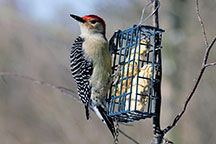
- Medium-sized woodpecker
- 9 to 10.5 inches in length
- Mainly light gray on the face and underbelly; black and white barred patterns on back, wings and tail. Adult males have red on the side of their head going from the bill to the nape. Females have a red patch on the nape and another above the bill.
- Red-bellied Woodpeckers are often mistakenly identified as Red-headeds, which have a much deeper red that covers their entire heads and necks.
Williamson’s Sapsucker (Sphyrapicus thyroideus)
- Medium-sizedwoodpecker
- Males are iridescent black on their head, back, sides and tail; black wings with large white patches; white stripe behind the eye and a lower white stripe across each side of the head; red chin and a bright yellow belly.
- The female looks completely different: pale yellow breast, a brownish head with black streaking and fine barring on the back, breast and sides.
Yellow-bellied Sapsucker (Sphyrapicus varius)
- Medium-sizedwoodpecker
- 7 to 8.7 inches in length
- Black on the back and wings with white bars, a black head with white lines on the side, a red forehead and crown, a white lower body, black tail with a white central bar, yellow upper belly and breast.
- Adult males have a red throat; females have a white throat.
- The birds can cause serious damage to trees, and intensive feeding has been documented as a source of tree mortality. Non-lethal deterrents can also be applied to trees to ward off the birds, including burlap wraps and bird tanglefoot (a type of sticky repellent).
Downy Woodpecker (Picoides pubescens)
- Smallest woodpecker inNorth America
- 5 to 7 inches in length
- Black on the upper parts of their bodies and wings, white back, throat and belly and white spotting on their wings; a white bar above and below the eyes; black tail with white outer feathers barred with black.
- Adult males have a red patch on the back of the head.
- The Downy Woodpecker’s bill is shorter than its head
Hairy Woodpecker (Picoides villosus)
- Medium-sizedwoodpecker
- 75 inches in length
- Black upper body and black wings with white spotting; white or pale back; white to sooty brown throat and belly; white bar above and below the eyes; black tail with white outer feathers.
- Adult males have a red patch or two side-by-side red patches on the back of the head.
- The bill is approximately the same length as its head.
American Three-toed woodpecker (Picoides dorsalis)
- Medium-sizedwoodpecker
- 8 to 8.5 inches in length
- Black on the head, wings and rump; white from the throat to the belly; flanks and back are white with black bars; tail is black with the white outer feathers barred with black
- The adult male has a yellow cap
- As its name suggests, it has 3 toes
Black-backed Woodpecker (Picoides arcticus)
- Medium-sized woodpecker
- 9 inches in length
- Black head, back, wings and rump; white from the throat to the belly; white flanks with black bars; black tail with white outer feathers; adult male has a yellow cap
- Three-toed feet
Northern Flicker (Colaptes auratus)
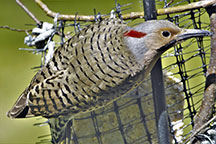
- Medium- to-large-sized woodpecker
- 11 to 14 inches in length
- Brown with black bars on the back and wings; black necklace-like patch on the upper breast, lower breast and belly arebeige with black spots; tail is dark on top, transitioning to a white bottom, which is conspicuous in flight; males have a black or red stripe at the base of the beak
Pileated Woodpecker (Dryocopus pileatus)
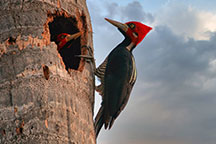
- Very largewoodpecker
- 16 to 19 inches in length; roughly the size of a crow
- Mainly black with a red crest and a white stripe down the sides of the throat; show white on the wings in flight.Adult males have a red line from the bill to the throat; in adult females these are black
Biology and Habits
Typically, woodpeckers reproduce in the spring. Certain species may begin breeding in the summer. A woodpecker female produces from one to three broods per year. Usually the female deposits 3-8 eggs per clutch. Eggs hatch in 11-14 days. The young grow and leave the nest in 2-5 weeks.
The primary diet of woodpeckers consists of insects, acorns, nuts, seeds, suet, berries and fruits.
Woodpeckers can be annoying to people. Their mating, feeding and nesting behaviors can cause extensive structural damage.
Tapping or drumming sound of woodpeckers is a communication tool. They pound their bill in a quick sequence against sound wood or metal to claim a territory or to attract mates. Drumming may occur throughout the year, but it is more common from April to June. Although woodpeckers often drum in the morning, there is no specific time for drumming. They may drum at any time of the day, especially before
Sunset. Drumming can be brief or go on for a long period of time (Goggans et al., 1988). Woodpeckers drum on different things. They may drum on hollow trees, homes, gutters, antennas, flashing, etc. But regardless of when they drum or how long it lasts, woodpecker drumming can cause anxiety for the homeowner.
Woodpeckers may dig unsightly holes in a structure looking for bugs to eat (usually near the eaves). These feeding holes may spread as several small (less than ½ inch) openings over an area. Or, they can be connected as rows. In this situation, they are following tunnels made by the wood-nesting insects, such as carpenter bees, leafcutter bees, carpenter ants, powder post beetles, etc.).
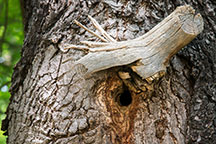
Woodpeckers also excavate a couple of larger holes, an inch or more, to roost. Most species will make their nests in trees. But unfortunately, they may nest also on the exterior walls of homes. Woodpeckers do not care about the wood species for nesting, but usually, they prefer soft wood. Thus, soft wood sidings, such as cedar or plywood, are known to be attractive to woodpeckers. Depending on the species, it can take the woodpecker two weeks or more to dig a nest.
In Minnesota, the yellow-bellied sapsuckers and flickers are migratory species. They leave for the winter and return in the spring. Other native species live in the state year-round.

